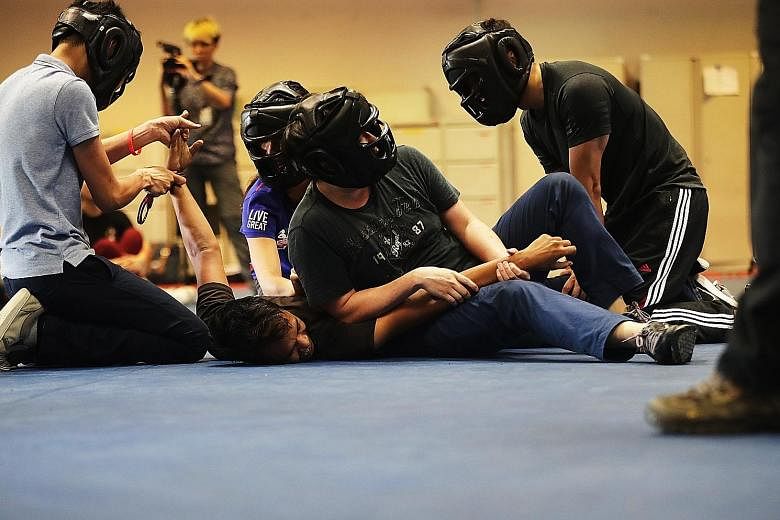A drunk man staggers, waving his arms and repeatedly kicking things towards bystanders. Two police officers approach him and try to calm him down but he ignores them, and struggles when they try to subdue him.
Eventually, it takes five officers to restrain and handcuff him.
Scenes like this - of subjects actively resisting arrest - have grown more common over the years.
A total of 412 cases were reported last year of Singapore Police Force (SPF) officers being physically or verbally abused on the job, 33 fewer than in 2016. The figure was just 314 in 2015.
Cases of physical hurt went up from 210 in 2016 to 246 last year.
Last year, the High Court rolled out a new sentencing framework and stiffened penalties in the light of a series of attacks on police officers. The revised framework provided for punishments ranging from a fine to up to seven years' jail.
Providing an insight into the inherent difficulties in arresting a non-compliant subject and the way in which officers often had to make spontaneous decisions, the SPF recently allowed various media, including The Straits Times, to observe a condensed version of their officers' basic training.
At the Home Team Academy on May 16, journalists were shown basic defensive stances and manoeuvres usually adopted by the officers, as well as more aggressive methods like palm heel and knee strikes.
The journalists were then paired up and shown the various armlocks that can incapacitate a suspect to allow him to be handcuffed. It took them several minutes to execute each movement smoothly, and much of that time was spent fumbling and twisting arms the wrong way. In real life, the "suspects" would have been able to flee.
The journalists role-played as police officers in an exercise involving an intoxicated subject. On the first attempt, they took almost 20 minutes to handcuff the suspect, even after calling for back-up. The second attempt took about 10 minutes. Both times, the "officers" had to resort to improvised tactics.
Out in the field, the force used can range from verbal commands to unarmed combat, Tasers and firearms.
The journalists were given the chance to use officers' extendable and heavy batons. They were told by instructors to hit a practice target with increasing force and to aim for the thigh area, which is cushioned with a larger proportion of fat and muscle to offset the blow.
They were also taken to a shooting range to fire a Taser, albeit using training cartridges with no current. Out in the field, an operational Taser delivers 50,000 volts of electricity, stunning any suspect for five seconds per cycle.
Superintendent Raymond Lo of the Frontline Policing Training Centre said that in deciding how much force to use, officers have to take into consideration multiple factors within a short period of time, including their own number, the crowd size, the environment and the suspect's physical profile.
He said that although officers are well-equipped with the necessary training, the situation on the ground is "often very dynamic".
"If you think about it, the aggressor often has the first-mover advantage, because he has to exhibit some level of aggression before officers will react," Supt Lo said.
He added that officers should "always expect the worst and be prepared for it".
Correction note: An earlier version of this report misspelt the Superintendent's surname. We are sorry for the error.

